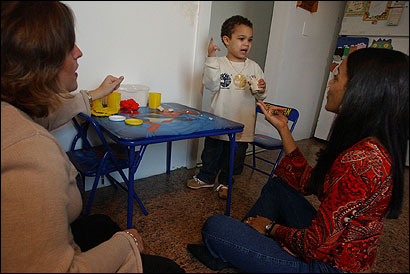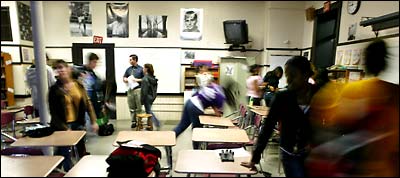Creating cultures of excellence in schooling
 Jill Whelan, a teacher who makes house calls for a state program (left), modeled parenting skills to Walquiria Nicasio. Whelan played with Nicasio’s son, Sebastian Rodriguez, 3, at their home in Lynn. (Lisa Poole for the Boston Globe)
Jill Whelan, a teacher who makes house calls for a state program (left), modeled parenting skills to Walquiria Nicasio. Whelan played with Nicasio’s son, Sebastian Rodriguez, 3, at their home in Lynn. (Lisa Poole for the Boston Globe)Doing some filing and I came across a couple articles I had meant to blog about in December. This article from the Boston Globe, "This preschool is for parents, too: State program sends teachers to families' homes to help them prepare toddlers for kindergarten," is relevant to the point I keep making about engaging families in the learning process from the very beginning.
From the article:
At its peak in 2002, the program reached 1,200 families. Whelan and other home visitors, dispatched in various communities, show parents how to teach their toddlers to speak, read, and develop motor skills with games and puzzles. The Department of Early Education Care, a new agency created in July, sees the program as key in a statewide effort to better prepare children for prekindergarten and kindergarten.
The Christian Science Monitor ran the article "Schools build 'cultures of excellence': Experts say bold, systematic leadership is key to success.', based on the work of the Education Trust and their discovery of best practices in high schools committed to excellence regardless of the socioeconomic status of the student population. " From the article:
Confronting achievement gaps and opportunity gaps is not optional at Los Altos High School in Hacienda Heights, Calif. Last year, Principal William Roberts posted some stark numbers over the copy machine, showing that Latinos made up 63 percent of the 2,000-plus student body but only 19 percent of Advanced Placement classes. He posed the question to the entire staff: What are we going to do about this? For one, they started talking to Hispanic parents and students, and found they had absorbed a lot of limiting messages. "When you hear kids say, 'Well, those classes are for the Asian kids,' that's painful," Mr. Roberts says, "but those realities have to surface ... to really address the issue."
By adding extra AP classes and providing support for any student who wanted to attend them, Los Altos boosted the Latino AP participation rate to 33 percent in one year.... It's one part of Roberts's insistence on a "culture of high expectations" at a public school that serves both poor and wealthy families...
 MOVING ON: Peter Weyler's (holding papers) 9th-grade English class is honors level - as are all classes for high-schoolers at the public University Park Campus School in Worcester, Mass. The school is exemplary for putting its students, many from low-income families, on the path to college. Photo: EMILY HARRIS, Christian Science Monitor.
MOVING ON: Peter Weyler's (holding papers) 9th-grade English class is honors level - as are all classes for high-schoolers at the public University Park Campus School in Worcester, Mass. The school is exemplary for putting its students, many from low-income families, on the path to college. Photo: EMILY HARRIS, Christian Science Monitor.Most high school leaders yearn to create such a culture, but it's hard to know how best to help students who enter ninth grade with significant skill deficits. To highlight concrete steps that some schools - including Los Altos - have taken, the nonprofit group Education Trust released an in-depth study last week titled "Gaining Traction, Gaining Ground: How Some High Schools Accelerate Learning for Struggling Students."
The study identified four "high impact" schools that serve a significant portion of low-income and minority students but do better than their counterparts in helping students catch up. It drew on surveys and focus groups with teachers and students, as well as direct observation of classrooms and school culture, interviews with administrators, and analyses of everything from class sizes to student transcripts.
These schools aren't at the top of the charts in terms of test scores, and they haven't eliminated achievement gaps, but they share "an absolutely unwavering commitment" to getting there, Ms. Haycock says.
Some of the practices that set the high-impact schools apart:
• They communicate consistently the goal of preparing students for college and careers, not simply graduation.
• They embrace external standards and assessment data to improve teaching.
• Students who need extra support are assigned to smaller classes led by more-experienced teachers; remedial work is done concurrently, rather than replacing grade-level courses.
• Students are encouraged to take challenging courses.
These steps often require reversing long-held traditions, as Principal Roberts discovered when he decided to start assigning the best teachers to the neediest students. "It runs contrary to the elitist feelings that all of us have helped cultivate in public schools, [the idea that] 'If I'm a great teacher, I get the honors kids,' " he says.
________
Setting high expectations makes a big difference.
Index Keywords: education



0 Comments:
Post a Comment
<< Home